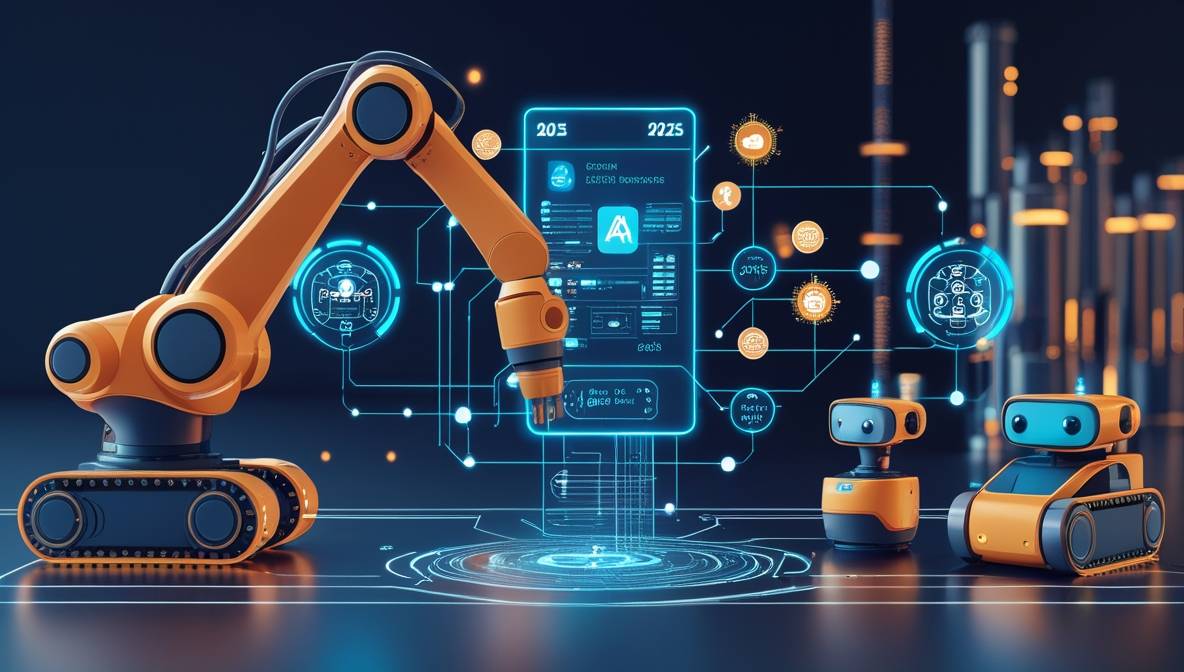Machine learning and automation are transforming industries in 2025, driving efficiency, innovation, and new possibilities. From generative models creating sophisticated content to small language models (SLMs) offering sustainable solutions, machine learning advancements are at the core of modern automation systems. These technologies are enabling smarter manufacturing, seamless IoT integration, and advanced robotics, impacting sectors like healthcare, finance, and transportation. This article explores the latest trends and innovations in machine learning and automation as of 2025, highlighting their applications, challenges, and future potential.
Machine Learning Trends in 2025
Generative Models
Generative models are leading machine learning innovations in 2025, creating complex content such as graphics, videos, and music. Models like Stable Diffusion, Muse, Imagen, Synthesia, Runway ML, Nvidia’s Fugatto, and Fluxmusic are enabling businesses to automate creative processes and enhance user experiences. The generative AI market is projected to grow at a compound annual growth rate (CAGR) of 37.6% from 2025 to 2030, reflecting its significant impact (Grand View Research). For example, Synthesia generates realistic videos from text inputs, widely used in marketing and education, while Stable Diffusion powers high-quality image creation for design industries.
| Generative Model | Primary Use | Industry Applications |
|---|---|---|
| Stable Diffusion | Image generation | Design, advertising |
| Synthesia | Video generation | Marketing, education |
| Nvidia’s Fugatto | Music generation | Entertainment, media |
Small Language Models (SLMs)
The shift from large language models (LLMs) to small language models (SLMs) is a key trend in 2025, driven by the need for resource efficiency. SLMs like Qwen and Pythia require fewer computational resources, making them more sustainable. For instance, daily ChatGPT usage consumes energy equivalent to 33,000 U.S. households, highlighting the environmental cost of LLMs (University of Washington). SLMs balance performance and cost, making them ideal for smaller businesses or applications with limited infrastructure, such as customer service chatbots or localized language processing.
GPUs and Optimized Computing
Graphical Processing Units (GPUs) are critical for training machine learning models efficiently. In 2025, cloud-based GPU solutions address hardware shortages and rising costs, enabling broader access to high-performance computing (MobiDev GPU Guide). Edge computing reduces latency for real-time applications, while quantum computing is gaining traction for future scalability. Companies like Google Cloud and Hugging Face offer quantization models to reduce model sizes, supporting applications like autonomous vehicles and smart manufacturing.
AutoML
Automated Machine Learning (AutoML) is democratizing machine learning by automating data preparation, model selection, and hyperparameter tuning. In 2025, AutoML is widely used in agriculture, cybersecurity, entertainment, marketing, and retail, enabling rapid deployment of ML solutions without specialized expertise. For example, AutoML tools can develop predictive models for crop yields or detect cyber threats, making advanced ML accessible to non-experts.
Multimodal Machine Learning
Multimodal machine learning integrates text, images, and sound, enabling context-aware systems. Applications include Visual Question Answering (VQA), Document VQA (DocVQA), Image Captioning, and Text-to-Image Generation. These capabilities enhance automation in customer service, where chatbots analyze both text and images to provide accurate responses, and in healthcare, where multimodal models assist in diagnostics by combining patient records and imaging data.
Few-shot and Zero-shot Prompting
Few-shot and zero-shot prompting address data scarcity, a critical challenge in machine learning. Few-shot learning uses a small number of examples to train models, while zero-shot learning relies on natural language instructions. These techniques are vital for applications like medical imaging, where limited data is available for rare diseases (MobiDev Few-shot Learning). In 2025, these methods are improving model generalization and reducing training costs.
Reinforcement Learning
Reinforcement Learning (RL) excels in robotics, finance, and healthcare, with techniques like Reinforcement Learning from Human Feedback (RLHF) incorporating human preferences to improve model performance. Fine-tuning Vision-Language Models (VLMs) with Chain of Thought (CoT) reasoning enhances their ability to handle complex tasks. RL is particularly impactful in robotics, enabling machines to learn from trial and error in dynamic environments, such as warehouse automation or surgical assistance.
MLOps
Deploying machine learning models remains a challenge, with 80% of projects failing to reach production. MLOps practices in 2025 address this through tools like MLflow, which includes components for Tracking, Models, Model Registry, and Projects. MLOps ensures models are scalable, maintainable, and integrated into production environments, supporting applications from predictive maintenance to personalized marketing.
Automation Trends Driven by Machine Learning in 2025
Smart Manufacturing
Machine learning is revolutionizing smart manufacturing by enabling predictive maintenance, real-time decision-making, and enhanced efficiency. By analyzing data from sensors and IoT devices, ML models predict equipment failures, reducing downtime by up to 30% (Industrial Automation India). This is critical in industries like automotive and electronics, where operational efficiency drives profitability.
IoT Integration
The synergy between machine learning and the Internet of Things (IoT) is a defining trend in 2025. IoT devices collect vast amounts of data, which ML algorithms analyze to provide actionable insights. This enables real-time monitoring and control, enhancing automation in logistics, where ML-powered IoT systems optimize supply chains by predicting demand and managing inventory dynamically.
Robotics
Machine learning is advancing robotics, enabling autonomous systems to learn and adapt. Reinforcement learning powers robots in warehouses, optimizing picking routes, and in healthcare, assisting with precise surgical procedures. These advancements improve efficiency and reduce human intervention, transforming industries from logistics to medical care.
Other Industries
Machine learning-driven automation is impacting healthcare, finance, and transportation. In healthcare, ML automates diagnostics and personalizes treatment plans. In finance, it streamlines fraud detection and risk assessment. In transportation, ML algorithms enable autonomous vehicles to navigate and make decisions, enhancing safety and efficiency (How AI is Transforming Industries).
| Industry | ML-Driven Automation Application | Impact |
|---|---|---|
| Healthcare | Automated diagnostics, personalized treatments | Faster, accurate patient care |
| Finance | Fraud detection, risk assessment | Improved security, efficiency |
| Transportation | Autonomous vehicle navigation | Safer, efficient mobility |
Challenges and Considerations
Ethical Concerns
As machine learning becomes pervasive, ethical issues like bias, privacy, and misuse are critical. Biased training data can lead to discriminatory outcomes in hiring or lending, necessitating fair and transparent models. Ensuring accountability is essential for maintaining trust in these technologies.
Sustainability
The environmental impact of machine learning, particularly energy consumption, is a growing concern. Training large models contributes significantly to carbon emissions. SLMs and energy-efficient algorithms are steps toward sustainability, but broader adoption of renewable energy sources is needed.
Regulatory Landscape
The regulatory environment for AI and ML varies globally. The EU’s AI Act sets strict standards for high-risk applications, while the U.S. adopts a lighter approach. Companies must navigate this complex landscape to ensure compliance while innovating (Top AI News 2025).
Looking Ahead
Machine learning and automation in 2025 are driving unprecedented innovation, from generative content creation to smart manufacturing. However, addressing ethical, sustainability, and regulatory challenges is crucial to maximize benefits. As these technologies evolve, they will continue to shape industries, offering new opportunities for efficiency and creativity. For more insights, explore related topics like Bitcoin Price Surges or Top 5 Cryptocurrencies to Watch This Week.

